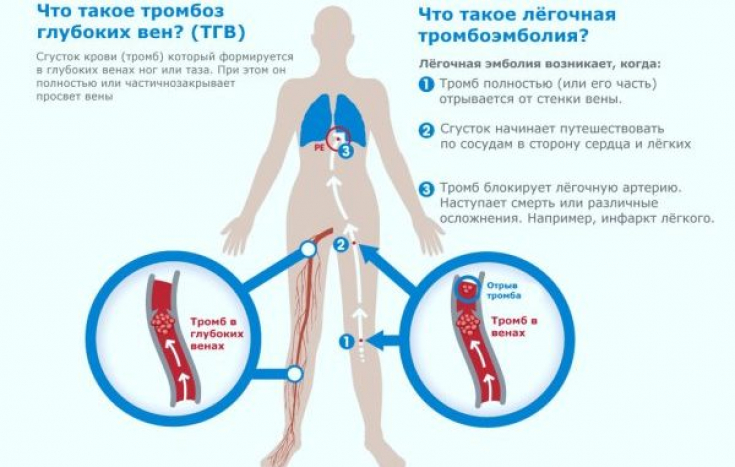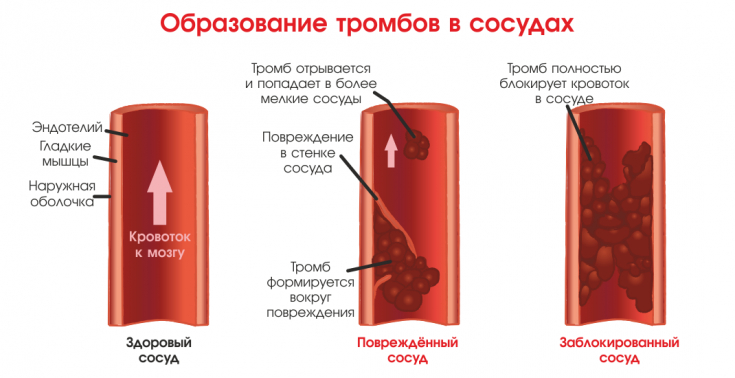In the human body, everything is perfectly balanced and designed to maintain health for many decades. But such a "calculation" does not take into account some features of modern life that can lead to disharmony in our body. One of the first it reacts — even minor changes in its composition can provoke life-threatening conditions.
One of them is the formation of blood clots — the reasons for the appearance of blood clots should be known to everyone who cares about their longevity.
- Causes of blood clots: the most significant risk factors
- How to eliminate the causes of blood clots and protect your health
Causes of blood clots: the most significant risk factors
If we distribute all the causes of blood clots according to their prevalence, then the "hit parade" will look like this.
Stagnation
This is the leading cause of blood clots and has a lot to do with lifestyle. Sedentary work, predominantly passive forms of recreation (watching TV, playing computer games, etc.) lead to the fact that blood lingers in the lower body longer than necessary. So, with a long sitting position, the legs become a risk zone, in which blood accumulates under the influence of gravity. Muscle work plays a very important role — their contractions allow you to resist the force of gravity and move the blood up — in & nbsp; large blood highways. If the muscles don work, the blood in the legs stagnates and due to its poor circulation is more likely that platelets "stick together" and form a clot.

Blood clotting disorders
Platelets are needed to form a blood clot. This is a very important component of the blood of a healthy person — such cells save us from blood loss, instantly responding to any injuries or internal damage and forming a "plug" sealing the circulatory system. It is this process that is the clotting function of the blood. But when the number of platelets is excessive, they form clots directly in the blood vessels.
Blood clotting disorders may occur under the influence of such circumstances:
-
Eating disorders. With an excess of fatty foods in the diet, the level of cholesterol in the blood increases, which has the properties of "glue" and leads to clumping of platelets.
-
Dehydration. When there is a lack of fluid, the blood becomes more viscous, which increases the likelihood of individual platelets and other blood cells sticking together in one mass.
-
Taking medications. For women, oral contraceptives pose the greatest danger. Or rather, their self-selection and uncontrolled intake, as these drugs increase the tendency to form blood clots.
Deadly danger: detecting and clot removal Vascular injury
Bruises (or hematomas) that form under the skin are known to everyone. In fact, they are blood coagulated under the influence of platelets — blood clots. Bruises usually do not carry any risks, since small vessels are injured and blood clots resolve relatively quickly directly at the site of injury. But a completely different picture is observed with extensive injuries or injuries of large vessels. Large blood clots are formed, which, due to their large size, cannot be quickly utilized by the body and create a potential threat — under unfavorable circumstances, they can break away from the vessel wall and begin to move along the bloodstream.
 How to eliminate the causes of blood clots and protect your health
How to eliminate the causes of blood clots and protect your health
The answer lies in the actual causes of blood clots: by normalizing physical activity, controlling your diet and taking medications only as prescribed by a doctor, you eliminate the main risk factors.
But the following tips will also be useful for those who monitor their health:
Read also:Myths about cholesterol: top 7 most enduring misconceptions
- Regularly monitor blood clotting.
A simple blood test will detect any abnormalities in time and take appropriate action.
If your family history - has been a history of heart attack, ischemic stroke, atherosclerosis
— consult your doctor. You may find it helpful to take prophylactic treatment with anti-clotting drugs 2-4 times a year.
In hot weather, elevated body temperature, sports or physical labor - keep an eye on replenishing the amount of fluid
that you lose with sweat.
Follow us on Telegram The greatest danger of blood clots lies in their gradual and invisible formation. But if you take preventive measures in time and monitor blood counts by regularly visiting a doctor, you can reduce the risks to your health and life to minimum.
Read also:Atherosclerotic heart disease: symptoms and treatments
You might be interested in: Gymnastics for the office.






Add a comment